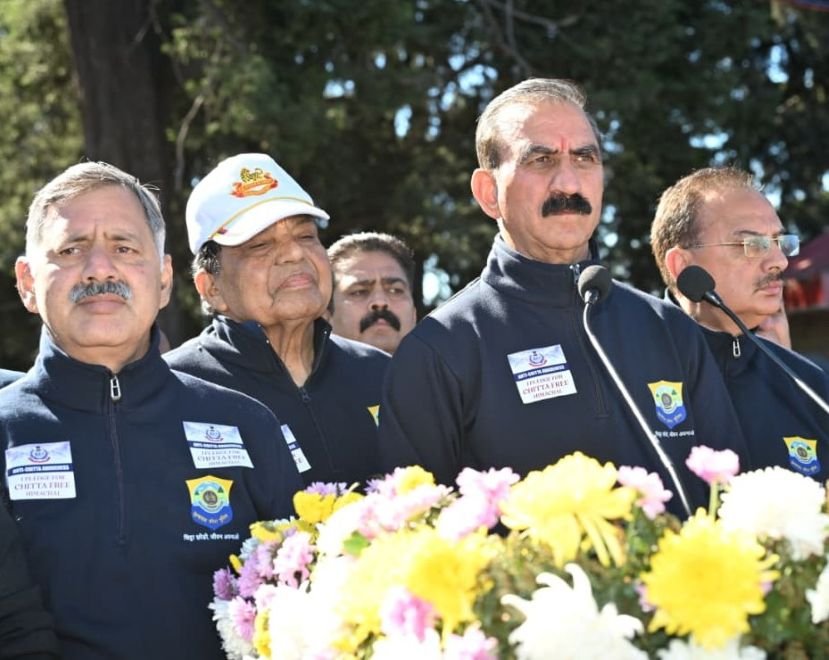Himachal Pradesh witnessed an unprecedented show of collective resolve as Chief Minister Thakur Sukhvinder Singh Sukhu led a massive ‘Chitta-Virodh’ Walkathon in Shimla, marking the beginning of what he described as one of the most decisive public campaigns in the state’s history. Starting from the Ridge and culminating at Chaura Maidan, the rally brought together thousands of students, public representatives, senior officials, and citizens from every section of society, signalling a united stand against the growing drug menace that has silently threatened the social fabric of the hill state.
Addressing the crowd at the Ridge, the Chief Minister administered an oath urging people—especially the youth—to stay away from drugs and addictive substances. He stressed that the battle against Chitta was not merely a governmental programme but a people-driven movement meant to protect future generations. The Chief Minister asserted that the drug problem had crept into communities quietly over the years, harming culture, values, and young lives, and now required an equally powerful and collective response. He noted that such mobilization, with widespread public participation, would deprive drug peddlers and mafias of any safe haven in the state.
Speaking at Chaura Maidan, CM Sukhu reiterated that the state would confront the challenge of Chitta together, turning this movement into a historic moment for Himachal Pradesh. He called upon citizens to ensure that those trafficking drugs are left with no escape routes or political shields. He emphasized that schools would not merely be centres of education but would also evolve into hubs of safety, awareness, and value-building for the youth. Appealing strongly to the women of the state, especially mothers, he said they held the power to steer this campaign more effectively than anyone else, as they are often the first to notice changes in children and the strongest voices in safeguarding families and communities.
The Chief Minister urged religious institutions across Himachal Pradesh to join the fight against drugs, stating that their moral authority could act as a powerful deterrent. If all temples, gurudwaras, churches, and other religious organizations stood together and raised their voice against narcotics, the state would witness a social awakening capable of dismantling the drug cartel network permanently. He also delivered a stern warning to drug traffickers and peddlers, declaring that those ruining young lives would find no place in the land of the gods. “Our police is ready, our government is ready, and more importantly our people are ready to root out Chitta,” he said, reinforcing the state’s zero-tolerance stance.
Elaborating on the government’s strategy, the Chief Minister said the campaign rests on three strong pillars: creating widespread awareness on drug abuse, preventing youth from falling prey to addiction by empowering law-enforcement agencies to crack down hard on mafias, and ensuring humane rehabilitation for those already trapped in addiction. He stressed that addicted youth were not criminals but victims needing treatment, counselling, and community support. To strengthen legal action, the state has implemented the Prevention of Illicit Traffic in Narcotic Drugs and Psychotropic Substances (PIT-NDPS) Act to ensure repeated offenders can be jailed without delay. Himachal has also passed new laws enabling stricter penalties—including life imprisonment, death penalty in extreme cases, fines up to Rs 10 lakh, and seizure of property owned by drug traffickers.
The state government is set to launch a team of 1,000 Anti-Chitta Volunteers who will work closely with police and local communities to identify drug users, suppliers, and emerging hotspots. Police departments have already been directed to map drug activity down to the panchayat level, a task that has now been completed. A Drug Prevention and Rehabilitation Board has also been established, and the government plans to introduce a dedicated chapter on drug awareness in school curricula, reflecting its focus on early education and prevention.
After completing the walkathon, the Chief Minister interacted with students, parents, and families who have personally suffered due to drug addiction. He listened to their stories, explained the harmful effects of Chitta, and assured full government support in their fight to rebuild their lives. Many residents expressed hope that such a sustained, people-centric movement, backed by strict enforcement and compassionate rehabilitation, would finally help the state break the cycle of addiction.
For years, drug networks, often shielded by deep-rooted political and financial influence, managed to evade law enforcement across many Indian states. Himachal Pradesh, too, has struggled with similar challenges. Local communities have long observed that the drug trade not only destroys lives but also fuels petty crime, exploitation, and social unrest. The new initiative by the state government marks an important shift in public sentiment and administrative resolve, bringing together legal, social, communal, and educational efforts under one united mission. The people of Himachal are now looking toward this campaign with renewed hope, expecting that a strict crackdown combined with widespread awareness will reshape the state’s future and protect generations to come.
